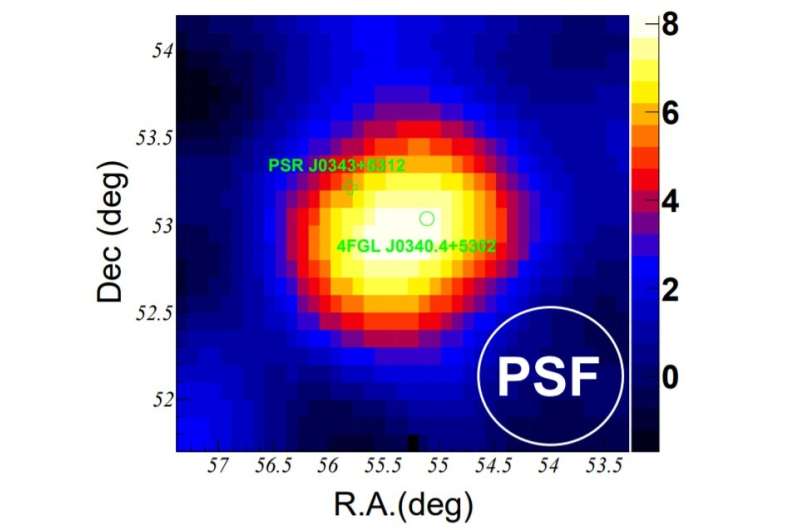The significance map of LHAASO J0341+5258 above 25 TeV. The green circle marks the position of 4FGL J0340.4+5302, and the blue cross marks the position of the pulsar PSR J0343+5312. Credit: Cao et al., 2021.
Astronomers from the Chinese Academy of Sciences (CAS) and elsewhere report the detection of a new ultra-high energy (UHE) gamma-ray source in the Galactic plane. The newly identified source, designated LHAASO J0341+5258, is extended and emission from it reaches up to 200 TeV. The finding is detailed in a paper published July 5 on arXiv.org.
Sources emitting gamma radiation with photon energies between 100 GeV and 100 TeV are called very-high energy (VHE) gamma-ray sources, while those with photon energies above 0.1 PeV are known as ultra-high energy (UHE) gamma-ray sources. The nature of these sources is still not well understood; therefore, astronomers are constantly searching for new objects of this type to characterize them, which could shed more light on their properties in general.
Now, a team of astronomers led by Zhen Cao of CAS has found a new source of this type using China's Large High Altitude Air Shower Observatory (LHAASO). LHAASO J0341+5258 was detected during an obervational campaign between December 2019 and November 2020.
"Since December 2019, the half of LHAASO-KM2A experiment has monitored the sky in the declination band from -15 degrees to 75 degrees above tens of TeV with high duty cycle. An excess with a pre-trial significance of 8.2σ was detected from the direction of LHAASO J0341+5258 using events with energy above 25 TeV," the researchers wrote in the paper.
The observations found that LHAASO J0341+5258 is an extended source with angular size of approximately 0.29 degrees. The gamma-ray emission from this source reaches values of nearly 200 TeV (0.2 PeV).
The results show that the integrated energy flux of gamma-ray emissions for LHAASO J0341+5258 above 25 TeV accounts for about 20 percent of the flux from the Crab Nebula. The astronomers added that energy spectrum of this source can be described by a power-law, even though there is a hint of curvature at around 50 TeV.
Furthermore, it was found that LHAASO J0341+5258 is positionally coincident with a known GeV gamma-ray source 4FGL J0340.4+5302. Therefore, the researchers assume that both sources may have a unified origin.
Summing up the results, the authors of the paper noted that LHAASO J0341+5258 could be an extended emission of a pulsar wind nebula (PWN) and/or a pulsar halo. However, the challenge of this scenario is the lack of a reported powerful pulsar.
"Interestingly, such a pulsar could be the gamma-ray source 4FGL J0340.4+5302 with a characteristic spectrum below 1 GeV. The detection of pulsed radio emission from this source would support the IC [inverse Compton] origin of the UHE gamma-ray emission," the scientists explained.
They added that hadronic origin of the UHE emission from LHAASO J0341+5258 can be interpreted as an 'echo' from molecular clouds. This is the result of interactions of protons with dense gas regions in the proximity of an old supernova remnant.
More information: Discovery of a new γ-ray source LHAASO J0341+5258 with emission up to 200TeV, arXiv:2107.02020 [astro-ph.HE] arxiv.org/abs/2107.02020
© 2021 Science X Network
























